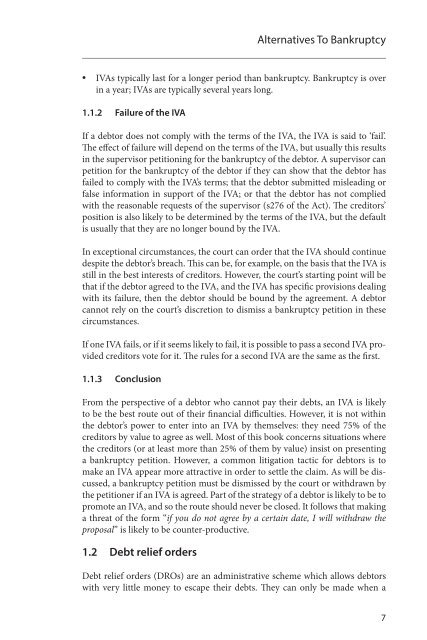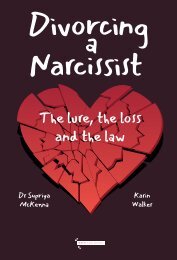Insolvency Made Clear: A Guide for Debtors
Plain English, practical guidance for anyone facing demands over a debt they are struggling to pay.
Plain English, practical guidance for anyone facing demands over a debt they are struggling to pay.
You also want an ePaper? Increase the reach of your titles
YUMPU automatically turns print PDFs into web optimized ePapers that Google loves.
Alternatives To Bankruptcy<br />
• IVAs typically last <strong>for</strong> a longer period than bankruptcy. Bankruptcy is over<br />
in a year; IVAs are typically several years long.<br />
1.1.2 Failure of the IVA<br />
If a debtor does not comply with the terms of the IVA, the IVA is said to ‘fail’.<br />
The effect of failure will depend on the terms of the IVA, but usually this results<br />
in the supervisor petitioning <strong>for</strong> the bankruptcy of the debtor. A supervisor can<br />
petition <strong>for</strong> the bankruptcy of the debtor if they can show that the debtor has<br />
failed to comply with the IVA’s terms; that the debtor submitted misleading or<br />
false in<strong>for</strong>mation in support of the IVA; or that the debtor has not complied<br />
with the reasonable requests of the supervisor (s276 of the Act). The creditors’<br />
position is also likely to be determined by the terms of the IVA, but the default<br />
is usually that they are no longer bound by the IVA.<br />
In exceptional circumstances, the court can order that the IVA should continue<br />
despite the debtor’s breach. This can be, <strong>for</strong> example, on the basis that the IVA is<br />
still in the best interests of creditors. However, the court’s starting point will be<br />
that if the debtor agreed to the IVA, and the IVA has specific provisions dealing<br />
with its failure, then the debtor should be bound by the agreement. A debtor<br />
cannot rely on the court’s discretion to dismiss a bankruptcy petition in these<br />
circumstances.<br />
If one IVA fails, or if it seems likely to fail, it is possible to pass a second IVA provided<br />
creditors vote <strong>for</strong> it. The rules <strong>for</strong> a second IVA are the same as the first.<br />
1.1.3 Conclusion<br />
From the perspective of a debtor who cannot pay their debts, an IVA is likely<br />
to be the best route out of their financial difficulties. However, it is not within<br />
the debtor’s power to enter into an IVA by themselves: they need 75% of the<br />
creditors by value to agree as well. Most of this book concerns situations where<br />
the creditors (or at least more than 25% of them by value) insist on presenting<br />
a bankruptcy petition. However, a common litigation tactic <strong>for</strong> debtors is to<br />
make an IVA appear more attractive in order to settle the claim. As will be discussed,<br />
a bankruptcy petition must be dismissed by the court or withdrawn by<br />
the petitioner if an IVA is agreed. Part of the strategy of a debtor is likely to be to<br />
promote an IVA, and so the route should never be closed. It follows that making<br />
a threat of the <strong>for</strong>m “if you do not agree by a certain date, I will withdraw the<br />
proposal” is likely to be counter-productive.<br />
1.2 Debt relief orders<br />
Debt relief orders (DROs) are an administrative scheme which allows debtors<br />
with very little money to escape their debts. They can only be made when a<br />
7













